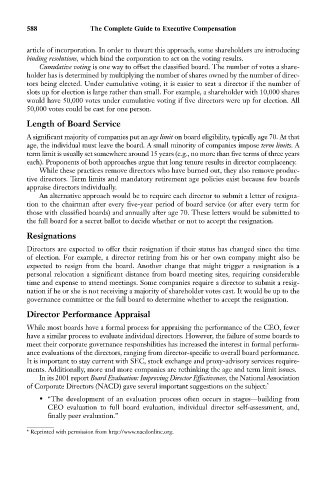Page 602 - Bruce Ellig - The Complete Guide to Executive Compensation (2007)
P. 602
588 The Complete Guide to Executive Compensation
article of incorporation. In order to thwart this approach, some shareholders are introducing
binding resolutions, which bind the corporation to act on the voting results.
Cumulative voting is one way to offset the classified board. The number of votes a share-
holder has is determined by multiplying the number of shares owned by the number of direc-
tors being elected. Under cumulative voting, it is easier to seat a director if the number of
slots up for election is large rather than small. For example, a shareholder with 10,000 shares
would have 50,000 votes under cumulative voting if five directors were up for election. All
50,000 votes could be cast for one person.
Length of Board Service
A significant majority of companies put an age limit on board eligibility, typically age 70. At that
age, the individual must leave the board. A small minority of companies impose term limits. A
term limit is usually set somewhere around 15 years (e.g., no more than five terms of three years
each). Proponents of both approaches argue that long tenure results in director complacency.
While these practices remove directors who have burned out, they also remove produc-
tive directors. Term limits and mandatory retirement age policies exist because few boards
appraise directors individually.
An alternative approach would be to require each director to submit a letter of resigna-
tion to the chairman after every five-year period of board service (or after every term for
those with classified boards) and annually after age 70. These letters would be submitted to
the full board for a secret ballot to decide whether or not to accept the resignation.
Resignations
Directors are expected to offer their resignation if their status has changed since the time
of election. For example, a director retiring from his or her own company might also be
expected to resign from the board. Another change that might trigger a resignation is a
personal relocation a significant distance from board meeting sites, requiring considerable
time and expense to attend meetings. Some companies require a director to submit a resig-
nation if he or she is not receiving a majority of shareholder votes cast. It would be up to the
governance committee or the full board to determine whether to accept the resignation.
Director Performance Appraisal
While most boards have a formal process for appraising the performance of the CEO, fewer
have a similar process to evaluate individual directors. However, the failure of some boards to
meet their corporate governance responsbilities has increased the interest in formal perform-
ance evaluations of the directors, ranging from director-specific to overall board performance.
It is important to stay current with SEC, stock exchange and proxy-advisory services require-
ments. Additionally, more and more companies are rethinking the age and term limit issues.
In its 2001 report Board Evaluation: Improving Director Effectiveness, the National Association
of Corporate Directors (NACD) gave several important suggestions on the subject: *
• “The development of an evaluation process often occurs in stages—building from
CEO evaluation to full board evaluation, individual director self-assessment, and,
finally peer evaluation.”
* Reprinted with permission from http://www.nacdonline.org.

